
- March 28, 2025
- Abi Therala
- 0
7 Best Email Parsers in 2025
Are you still copying and pasting data from emails into spreadsheets? We’ve been there, and it’s mind-numbing work that eats up precious hours of your week.
In fact, our research shows that the best email parser tools can save you over 10 hours every week by automating data extraction from emails. These tools work 24/7, eliminating human error and freeing up your team to focus on growth-driving activities.
We’ve thoroughly evaluated the top email parser software options to help you choose the right one for your needs. From AI-powered features to seamless CRM integrations, here are the 7 best email parser tools that will transform how you handle data in 2025.
1. Mailparser: The Pioneer in Automated Email Parsing
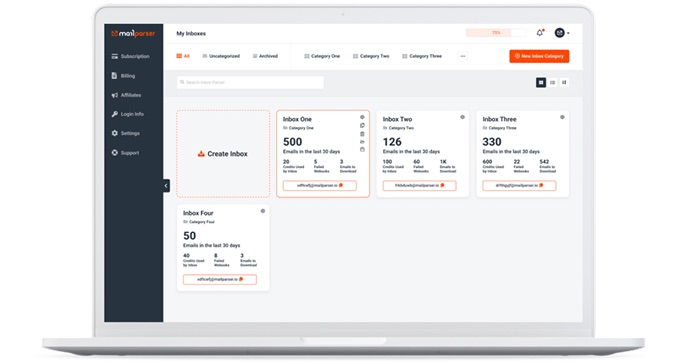
Image Source: mailparser.io
Looking for a way to rescue data trapped in your inbox? Mailparser stands as the undisputed market leader in the email parsing space, capturing over 52% of the market share for good reason. This pioneering tool transforms how businesses handle email data extraction, saving teams countless hours of tedious work.
How Mailparser Transforms Your Email Workflow
Mailparser fundamentally changes how you process incoming emails by automating data extraction from both email bodies and attachments. Instead of manually copying information from emails into spreadsheets or databases, I simply forward emails to a dedicated Mailparser address where the magic happens automatically.
The workflow is brilliantly simple: forward emails to Mailparser, let it extract data based on your custom parsing rules, and watch as that structured data flows directly into your business applications or downloads as usable files. Many businesses estimate this automation saves them 10+ labor hours per week, effectively paying for itself many times over annually.
What truly sets this workflow apart is its set-it-and-forget-it nature. Once you’ve established your parsing rules, the system works tirelessly in the background, eliminating human error and freeing up your team to focus on more valuable tasks.
Key Features That Make Mailparser Stand Out
As the pioneer in email parsing, Mailparser offers a robust feature set that distinguishes it from competitors:
- Comprehensive Data Extraction: Beyond email body text, Mailparser extracts data from subject lines, sender information, and multiple attachment formats including PDF, DOC, DOCX, XLS, XLSX, CSV, TXT, and XML files.
- Powerful Filtering Options: The platform includes advanced table and list parsing filters that can extract table rows, repeating text blocks, and apply conditional text filters.
- Rule Customization: Users can create detailed parsing rules with duplicate filters, capitalization controls, search and replace functions, and row insertion capabilities.
- Extensive Integration Network: Connects with 1,500+ applications through Zapier and Microsoft Flow integrations, making it versatile for any tech stack.
- User-Friendly Interface: Designed for non-programmers, the intuitive interface doesn’t require coding knowledge.
One particularly noteworthy feature is Mailparser’s ability to extract data from email attachments, which many similar tools struggle with. This capability proves invaluable for businesses dealing with invoices, purchase orders, or shipping notifications contained in attached documents.
2. Parseur: AI-Powered Data Extraction at Scale
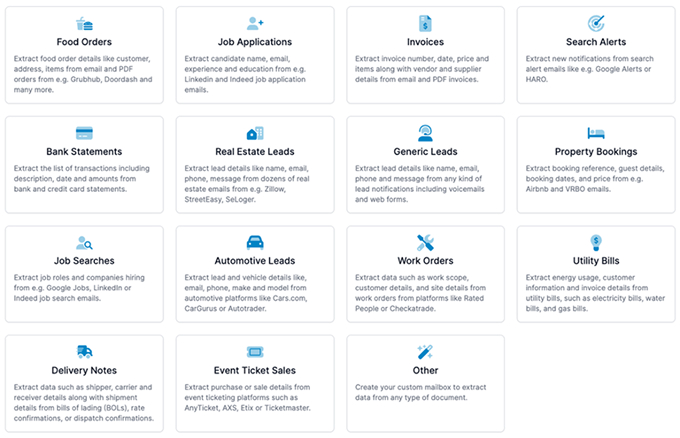
Image Source: parseur.com
When email data feels trapped in an endless stream of messages, Parseur offers a compelling solution with its unique AI-powered approach. Launched in 2016, this cloud-based document parser has established itself as a formidable player in the email parsing landscape, particularly for those seeking advanced automation without coding skills.
Parseur’s Unique Approach to Email Parsing
Parseur stands out from traditional parsing tools through its dual-engine approach. The platform offers both AI-powered and template-based parsing, giving users flexibility based on their specific needs. With the AI engine, you simply list the data fields you want to extract, and Parseur intelligently identifies and extracts them without requiring complex rules.
What makes this approach particularly powerful is that unlike many competing AI tools, you don’t need to extensively train the model—Parseur comes pre-trained with ready-made fields for common data extraction scenarios. Furthermore, their latest AI engine (v2) delivers more accurate results, especially when processing longer documents.
Beyond just emails, Parseur extracts data from:
- Email attachments (including zipped files)
- PDFs (including scanned documents via OCR)
- Spreadsheets and CSV files
- Word documents and HTML files
One distinctive feature is Parseur’s rich HTML email parsing capability, which displays emails exactly as they appear in your email client—with formatting, colors, tables, and images intact. This makes template creation significantly more intuitive since you’re working with the familiar layout.
Integration Capabilities That Streamline Your Workflow
Parseur truly shines in how seamlessly it connects with other business tools. The platform integrates natively with:
- Zapier (connecting to thousands of applications)
- Microsoft Power Automate (for deep Microsoft ecosystem integration)
- Make.com (formerly Integromat)
- Google Sheets (for immediate data visibility)
- Excel and CSV (for direct downloads)
These integrations enable powerful automation sequences. For instance, whenever an email arrives with business data, Parseur can extract that information and instantly send it to your CRM, spreadsheet, or other business applications in real-time. A real-world example is automatically creating new Google Sheet rows with extracted data through the Integrately integration.
The platform also offers webhook functionality for developers wanting custom integrations with their own applications. This versatility makes Parseur adaptable to virtually any workflow, regardless of your existing tech stack.
According to Parseur’s internal data, the average customer saves approximately 189 hours of manual data entry monthly—equivalent to about $7,557 in labor costs. This makes the service roughly 98% cheaper than manual entry, representing potential savings of over $90,000 annually.
For businesses drowning in email data, Parseur offers a compelling blend of powerful AI capabilities, extensive integration options, and a pricing structure that scales with your needs.
3. Wend AI: Revolutionary Email Parsing with Advanced AI
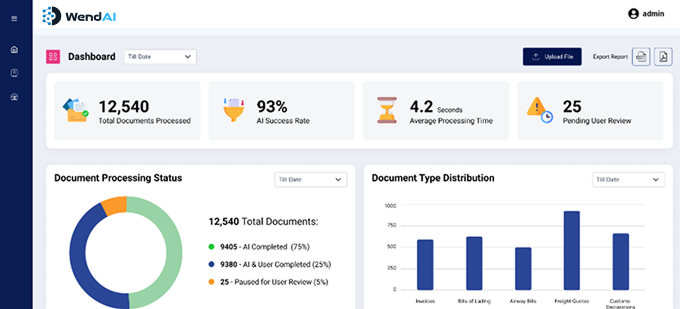
Image Source: Turing IT Labs
Ever wondered how AI can transform your email chaos into organized, actionable data? Wend AI stands as a significant breakthrough in the email parsing landscape, bringing advanced AI capabilities that go well beyond standard template-based solutions.
Wend AI’s Core Parsing Capabilities
Wend AI excels at extracting structured data from unstructured text without requiring coding skills. What sets it apart from traditional parsing tools is its ability to identify and extract specific information from a variety of sources—not just email bodies but also attachments and other textual sources. The system works tirelessly to pull out:
- Names, addresses, and contact details
- Dates, times, and scheduling information
- Product specifications and pricing details
- Custom field data based on your business needs
First and foremost, Wend AI serves as your digital assistant, capturing lead information from incoming messages or documents and automatically categorizing it for seamless follow-up. This capability makes it particularly valuable for teams drowning in customer communications or sales inquiries.
How Wend AI Outperforms Traditional Parsing Methods
The magic behind Wend AI lies in its advanced transformer-based machine learning models. Unlike conventional parsing tools that rely on rigid rules, Wend AI leverages sophisticated AI models similar to GPT derivatives to understand context and relationships between data points.
In essence, Wend AI doesn’t just extract keywords; it comprehends how those pieces of information relate to each other. This nuanced understanding allows for remarkably precise data extraction even from emails with irregular formats or varying structures.
Furthermore, the AI models cross-verify extracted data against predefined business rules and patterns, dramatically reducing errors that plague manual data entry processes.
Integration Ecosystem and Workflow Automation
Wend AI employs an API-driven architecture that integrates directly with your existing systems. This technical foundation ensures real-time, bidirectional data flow between Wend AI and your other business applications.
As a result, you can:
- Automatically populate fields in your CRM or ERP with verified data.
- Generate actionable insights directly within operational dashboards.
- Create custom workflows tailored to your specific needs.
The system toggles seamlessly between fully autonomous and assisted modes, giving you complete control over how much human oversight remains in your workflow. Therefore, whether you need a fully automated solution or prefer keeping humans in the loop for certain decisions, Wend AI adapts to your preferences.
Organizations Saving 15+ Hours Weekly
The true testament to Wend AI’s effectiveness comes from organizations using it to transform their operations. McKinsey reports that companies adopting AI-powered tools like Wend AI have seen a 40% improvement in their deal win rates by responding faster to opportunities.
One organization reported saving over 15 hours weekly by automating their email processing workflow. Above all, this time savings allowed their team to focus on strategic activities rather than data entry.
Another company highlighted how Wend AI ensured their extracted data aligned perfectly with international standards, significantly reducing compliance risks that previously required extensive manual verification.
Wend AI proves particularly valuable for businesses handling high volumes of similar emails that contain different data points each time—precisely the scenario where manual processing becomes most error-prone and time-consuming.
4. Zapier Email Parser: Seamless Integration for Automation Enthusiasts
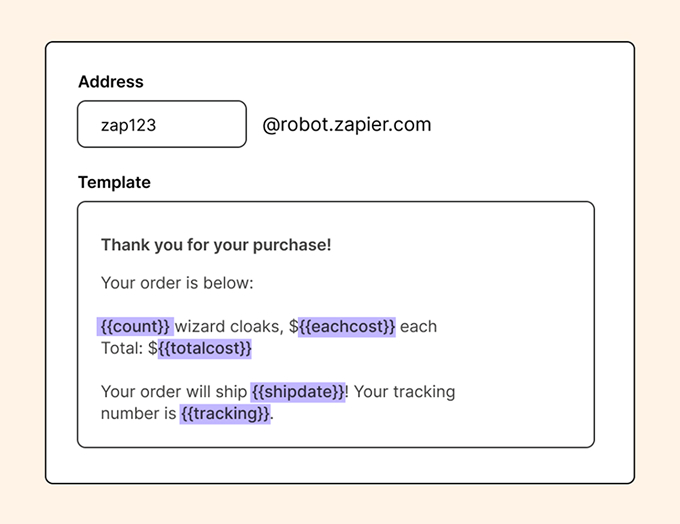
Image Source: Zapier
For those already invested in the Zapier ecosystem, there’s a straightforward email parsing solution built right into the platform. Zapier Email Parser stands as the no-frills contender on our list—a free tool that, while simpler than its premium counterparts, offers seamless integration with thousands of apps.
Setting Up Your First Parsing Workflow
Getting started with Zapier Email Parser is refreshingly straightforward. Initially, you’ll need to visit parser.zapier.com and sign in with your existing Zapier account (or create one). After signing in, simply click the “Create Mailbox” button to generate a custom @robot.zapier.com email address.
Once you have your dedicated parsing address, the setup follows these simple steps:
- Forward a sample email to your new @robot.zapier.com address
- When your email arrives, Zapier displays a text version in the “Initial Template” box
- Highlight the important data elements you want to extract
- Name each highlighted item (like “total” or “customer_name”)
- Click “Save Template” to complete the process
To enhance accuracy, you can create additional templates from similar emails. Subsequently, set up automated email forwarding rules in your email client to route incoming messages directly to your parser.
The real power emerges when you connect your parsed data to other apps through Zapier’s workflows (called Zaps). Hence, you can automatically populate spreadsheets, create calendar events, or update your CRM with extracted information.
Limitations and Workarounds
Although convenient, Zapier Email Parser has notable constraints compared to dedicated parsing solutions:
- Size Restriction: A 25MB limit per email, which can be problematic for emails with large attachments
- Template Limitations: Only 15 template variations allowed per mailbox
- Parsing Accuracy: The algorithm lacks sophisticated pattern-matching capabilities compared to human recognition
- Attachment Handling: Cannot parse the contents of email attachments, unlike premium alternatives
Thankfully, several workarounds exist. To improve parsing accuracy, structure your emails with data fields on separate lines or use non-space delimiters like the “|” character to separate data points. Furthermore, for forwarded emails, copy-pasting content into a new message often yields better results by eliminating extra threads and signatures that confuse the parser.
If you encounter persistent parsing issues, Zapier offers three parsing engines that you can switch between. To change engines, click the “cog” icon next to your mailbox and select another option from the dropdown menu.
Best Use Cases for Zapier’s Email Parser
Zapier’s parser truly shines in specific scenarios:
- Simple Text Emails: Works exceptionally well with cleanly formatted emails containing consistent layouts.
- Zapier Ecosystem Users: Ideal if you’re already utilizing Zapier for other automations.
- Basic Integration Needs: Perfect for sending parsed data to Google Sheets, Calendar, Slack, or Mailchimp
- Lightweight Parsing Requirements: Great for users just beginning with email automation
- Budget Constraints: Being free with all Zapier plans makes it ideal for those not ready to invest in premium solutions
The tool performs admirably when emails have consistent structures and when template emails are straightforward. Yet, for more complex parsing needs—particularly involving attachments or irregular formats—Zapier itself recommends more robust solutions like Mailparser or Parseur.
What makes this tool particularly valuable is its seamless connection to Zapier’s vast integration network. Accordingly, once you’ve extracted your data, you can immediately put it to work across thousands of applications without additional setup complexities.
5. Airparser: Next-Generation GPT-Powered Parsing
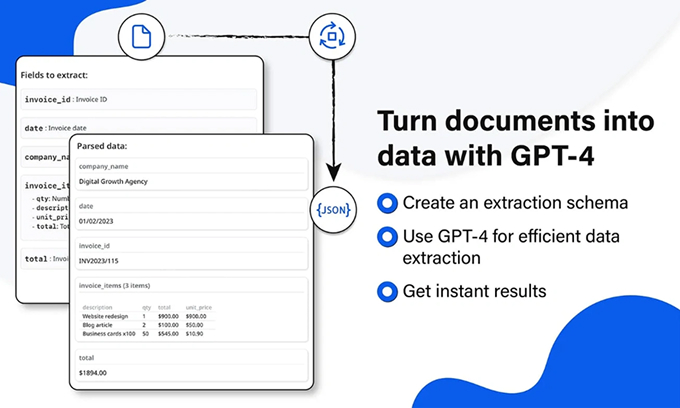
Image Source: Airparser
Imagine having an AI assistant that not only reads your emails but understands them like a human would. That’s what Airparser brings to the table as a next-generation parsing solution built on the powerful foundation of GPT technology. Unlike traditional template-based tools, Airparser represents a fundamental shift in how we extract data from unstructured documents.
How Airparser Leverages GPT for Superior Accuracy
Airparser’s magic lies in its sophisticated GPT-powered parsing engine. This isn’t just another rule-based system – it’s an intelligent parser that understands context and meaning within your documents. The platform utilizes both GPT and custom Large Language Models (LLMs) to ensure remarkably precise data extraction.
What sets Airparser apart is its contextual understanding capabilities. While traditional parsers rely on rigid templates that break when email formats change, Airparser’s AI engine adapts automatically to different layouts. This means you don’t need to create separate templates for each email format – the system learns and improves without constant reconfiguration.
Furthermore, Airparser’s technology excels at handling unstructured data through its contextual understanding. The system can process documents in over 60 languages, including typed, scanned, and even handwritten text – a capability that puts it leagues ahead of conventional parsing tools.
Setting Up Complex Parsing Rules Without Coding
Getting started with Airparser involves creating an extraction schema – essentially, a structured framework that tells the AI what data to look for. Yet, unlike template-based systems, you don’t need to write complex rules or logic chains.
Setting up is remarkably straightforward:
- Create a dedicated inbox for your parsing needs
- Define what data you want to extract
- Write descriptive prompts telling the AI what to find
- Watch as Airparser automatically extracts the information
One particularly powerful feature is the ability to process both email bodies and their attachments simultaneously. Airparser can handle PDFs, images, HTML files, text documents, and even scanned materials with its OCR capabilities. Basically, regardless of where your important data lives, Airparser can find and extract it.
Throughout the user experience, Airparser maintains security as a priority with 256-bit AES encryption and secure data transmission protocols. Notably, businesses can customize retention periods to meet their specific compliance requirements.
6. Parsio: Flexible Parsing for Multiple Document Types
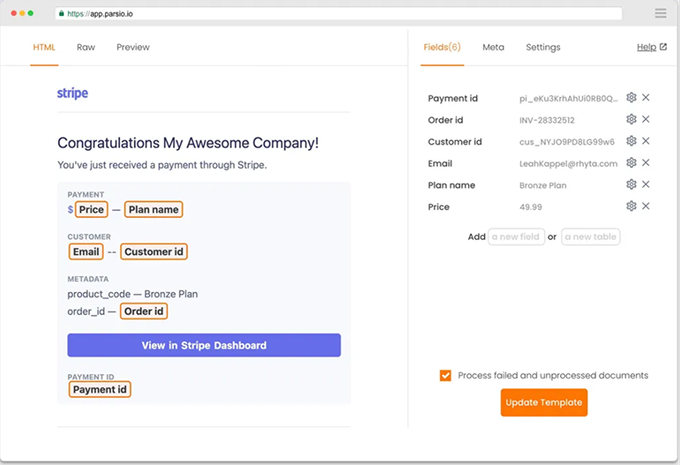
Image Source: Parsio
Handling diverse document formats can feel like trying to speak a dozen languages simultaneously. Parsio tackles this challenge head-on, serving as your multilingual translator for various data formats.
Beyond Email: Parsio’s Multi-Format Capabilities
Parsio excels at extracting structured data from numerous document types beyond just emails. The platform processes PDFs, HTML, Excel files (XLSX), CSV, DOCX, XML, JSON, and plain text documents with equal proficiency. First and foremost, it captures data from all elements of an email—subject lines, body content, attachments, and even metadata like sender addresses and timestamps.
What truly distinguishes Parsio is its advanced OCR technology. This feature recognizes both handwritten and printed text in multiple languages, making it valuable for businesses handling international documents. Due to its pre-trained models, the system automatically extracts data from invoices, receipts, business cards, and ID documents without extensive configuration.
Template vs. AI-Based Parsing: When to Use Each
Parsio offers three distinct parsing engines, each optimized for specific scenarios:
- Template-based parser (1 credit/document): Ideal for emails and documents with fixed layouts, such as transactional machine-generated emails
- AI-powered PDF parser (5 credits/page): Perfect for invoices, receipts, and documents requiring OCR capabilities
- GPT-powered parser (2 credits/page): Best suited for complex, unstructured documents where creating templates proves challenging
In light of these options, structured documents with consistent formats work best with template-based parsing, while variable-layout documents benefit from the AI or GPT engines.
7. Email Parser by Nanonets: Enterprise-Grade Parsing Solution

Image Source: Nanonets
Processing mountains of email data daily? Nanonets delivers an enterprise-grade email parsing solution that stands apart through its advanced AI capabilities and unmatched scalability.
Advanced Machine Learning Capabilities
Unlike template-based parsers, Nanonets employs an AI-based approach without requiring predefined rules or templates. This fundamental difference allows it to handle unpredictable email formats with remarkable flexibility. The system’s deep learning models and advanced OCR technology work in tandem to extract data from both email bodies and attachments.
Meanwhile, the parser’s machine-learning algorithms continuously improve with usage, becoming increasingly accurate over time. This self-learning capability makes Nanonets particularly valuable for organizations dealing with evolving document layouts.
Beyond simple text extraction, Nanonets excels at processing:
- Multiple file types including PDFs, images, spreadsheets, JSON, and XML
- Unstructured and semi-structured data through NLP models
- Data from up to 20 attached documents per email
Handling High-Volume Email Processing
In contrast to basic parsing tools, Nanonets thrives in high-volume environments. One organization successfully automated processing for approximately 12,000 invoices monthly using the platform. Furthermore, the system demonstrated processing speeds of 173-174 invoices in just five minutes—a task that would typically require hours of manual data entry.
The workflow is straightforward yet powerful:
- Capture emails through forwarding or direct collection
- Extract relevant data from email bodies, subjects, and attachments
- Transform and download data or sync directly with business applications
To determine if Nanonets fits your needs, consider your document volume, complexity of extraction requirements, and integration needs with existing business systems. Organizations processing thousands of documents monthly with intricate data formats will benefit most from this robust solution.
Comparison Table
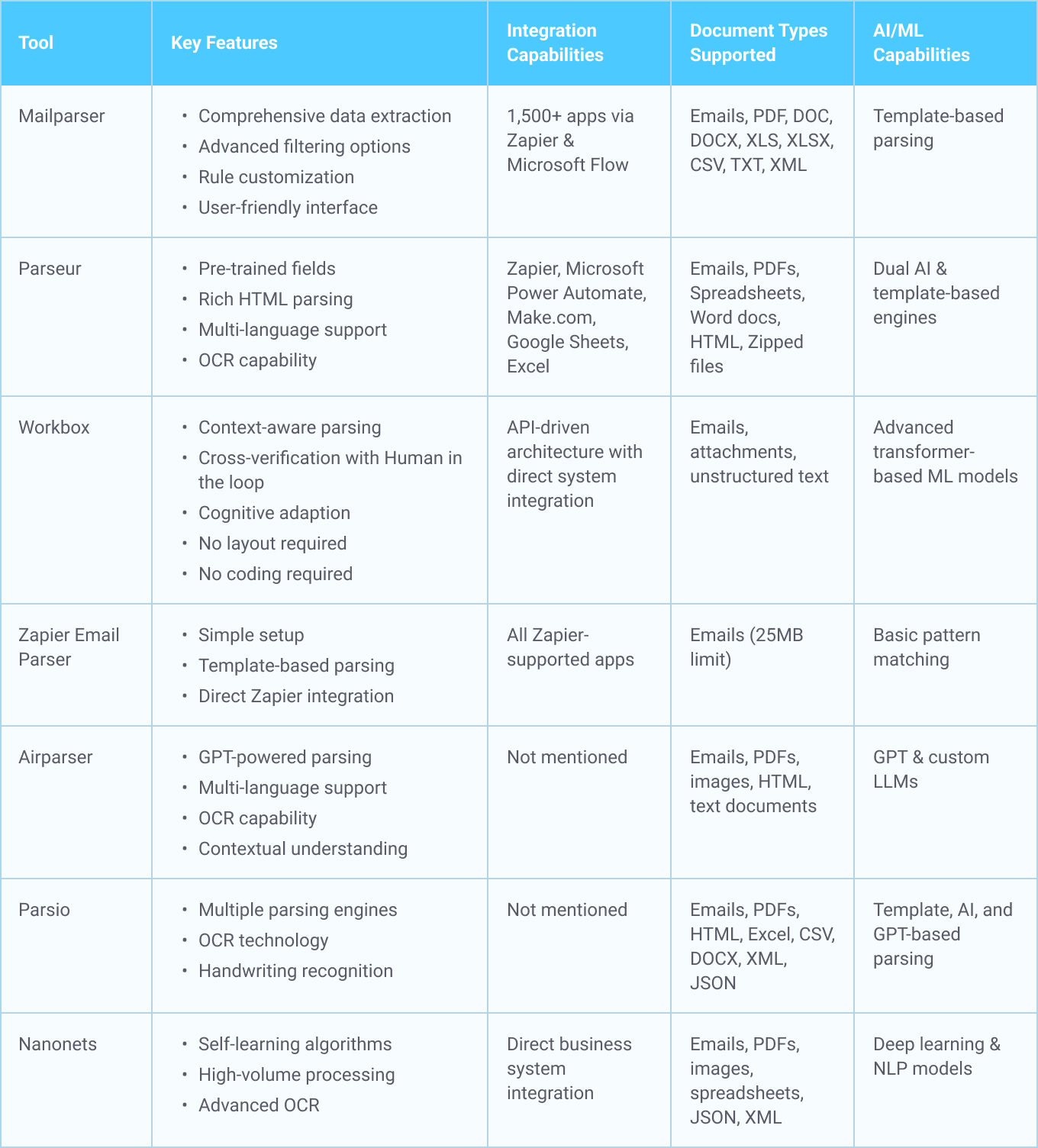
Conclusion
Above all, success with email parsing comes down to matching your specific needs with the right tool. Consider your email volume, document complexity, and integration requirements.
Start with a free trial of your chosen solution – most providers offer one. This hands-on experience will help you understand how these tools can transform your workflow.
The future of email parsing looks promising as AI continues advancing. These tools will become smarter, faster, and more accurate, making data extraction even more seamless. Therefore, now is the perfect time to automate your email processing and free up your team for more valuable tasks.


